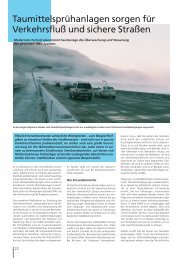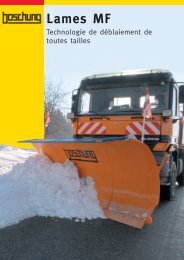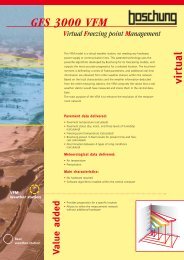Physical bases of freezing point measurement using ... - Boschung
Physical bases of freezing point measurement using ... - Boschung
Physical bases of freezing point measurement using ... - Boschung
You also want an ePaper? Increase the reach of your titles
YUMPU automatically turns print PDFs into web optimized ePapers that Google loves.
Proceedings <strong>of</strong> the 9 th SIRWEC Conference 15-17 March 1998, Luleå, Sweden 279<br />
in [Franks 1972], those <strong>of</strong> pure ice in [Hobbs 1974, Jaccard 1959, Ruepp 1973, Franks 1982]<br />
and those <strong>of</strong> aqueous electrolyte solutions in [Horvath 1985, Franks 1973]. Data are given in<br />
[Zaytsev and Aseyev 1992, Barthel et al. 1995].<br />
4. DISCUSSION<br />
4.1 Utilization <strong>of</strong> active and passive probes<br />
As we have seen, the first goal <strong>of</strong> the active probe is to measure the <strong>freezing</strong><br />
temperature. However it allows also to measure the surface temperature Tr <strong>of</strong> the road. In that<br />
case, stabilization between cycles would have to be performed. It is interesting to note that the<br />
surface temperature <strong>of</strong> the road could be difficult to measure with only one probe. As shown<br />
by Scharsching [Scharsching 1991] its value is not homogeneous on all the surface <strong>of</strong> the<br />
road. The location <strong>of</strong> the probe has to be chosen with care.<br />
It is also possible to use in the same vicinity all together an active an a passive probe,<br />
the first one measuring Ts and the second one 7 Tr. The last possible configuration is to use<br />
only a passive probe, in conjunction with meteorological sensors (relative humidity,<br />
precipitation, etc.).<br />
4.2 Salt content<br />
For the road's winter maintenance executive, the knowledge <strong>of</strong> the <strong>freezing</strong> temperature,<br />
as important it could be, is nevertheless not sufficient. Due to precipitation, streaming or<br />
evaporation, the amount <strong>of</strong> water on the pavement, and then the concentration <strong>of</strong> chemical<br />
and the <strong>freezing</strong> temperature, may vary. The parameter which can be used to characterize the<br />
protection rate <strong>of</strong> the road is the salt content. As it will be shown, it can be deduced from the<br />
<strong>freezing</strong> temperature and the thickness <strong>of</strong> the solution. The example <strong>of</strong> spreading solid<br />
sodium chloride as anti-icing treatment will be considered.<br />
The quantity <strong>of</strong> salt spread by the service vehicle can be chosen to give a salt content s<br />
comprised between 5 and 40 g/m 2 . After the salting, the mass mNaCl <strong>of</strong> salt laying on an area A<br />
<strong>of</strong> the pavement is given by :<br />
m = s⋅<br />
A . (6)<br />
NaCl<br />
If salt is diluted in a certain amount mH 2 O <strong>of</strong> water (in order <strong>of</strong> simplification, the salt<br />
content on the area A is kept constant), the weight concentration c <strong>of</strong> NaCl will be :<br />
mNaCl<br />
c =<br />
m + m<br />
NaCl H2O m<br />
=<br />
m<br />
NaCl<br />
tot<br />
, (7)<br />
7 The passive probe has to be placed far enough from the active one in order to be not influenced by it.
















